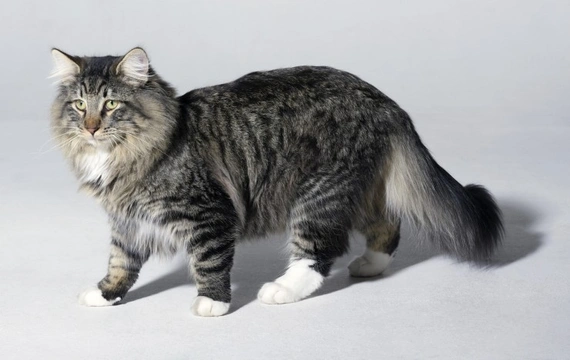
Do you know your cat’s body condition score?
Being able to tell if one’s own cat is at an appropriate weight can be a challenge, not only because we see our own pets every day and so, are less likely to notice slow fluctuations in their weight, but also because many cat owners aren’t really sure how to determine what a healthy weight is by observation.
Just as humans come in all shapes and sizes due to our natural differences and of course, can be underweight or overweight as well, so too do cats come in a huge variety of different sizes and weights as well, which means that using weight alone to assess your cat’s build will not produce an accurate result.
Certain breeds of cat also tend to be larger, heavier and more muscular than others, such as the Norwegian forest cat, which can weigh up to around seven or eight kilograms at an appropriate weight, compared to the four to five kilograms that is a broad norm across the cat population as a whole.
However, by using body condition scoring to assess your own cat’s build, you can help to ascertain where they fall on a scale in terms of their weight and build, and how appropriate it is. There is a standardised system used by veterinary professionals and other organisations that ranks a cat’s body condition along a sliding scale – and this can be used by cat owners too to help to determine how appropriate their cat’s weight is too.
In this article, we will explain what body condition scoring for cats is, how it works, and why it is used – and how to determine your cat’s own score. Read on to learn more.
What is a cat body condition score?
Cat body condition scoring uses a widely recognised system to rank a cat’s condition on a sliding scale, from emaciated at the bottom end to severely obese at the top end. Currently, there are two different scales in use, one ranging from numbers 1-9, and the other from numbers 1-5.
Because both of these scales are widely used, when a score on the scale is used professionally to pass on information about a cat’s build, it is also important to specify whether the 1-9 or the 1-5 scale was used, in order to return the correct result!
The 1-9 scale is the most commonly used today, and will give a more detailed and accurate return of the cat’s body condition without the need to use half-numbers.
What is body condition scoring used for?
Veterinary professionals often use body condition scoring as part of their clinical notes, to refer back to later on during a treatment, or over the course of the cat’s life, and as part of information on an animal’s clinical history when they are treated by different vets.
Pet insurance companies also sometimes request this information from your vet if you make a claim on your policy, and this information may be used to confirm that your pet was appropriately cared for or to indicate any problems that may have become apparent before a health condition arises.
The scale is also used in cases of neglect and animal cruelty prosecutions too.
Determining your cat’s body condition score
As mentioned, cat body condition scoring can either follow a 1-9 scale or a 1-5 scale.
Below, we will outline what a cat’s body looks like at each number on the 1-9 scale, with the equivalent 1-5 scale ranking in brackets.
Level 1 (1)
Emaciated, dangerously underweight. The ribs will be visible (on cats with short hair) and the abdominal tuck will be acute, among other indicators.
Level 2 (1.5)
Very thin, with ribs easy to see on cats with short hair, minimal musculature and no palpable fat.
Level 3 (2)
Thin, with ribs having the lightest covering of fat and being easy to feel with a light touch. There will be minimal body fat over the abdomen, and a clearly delineated waist behind the cat’s ribs.
Level 4 (2.5)
Underweight, with a clear waist and ribs that you can feel, and no fat pad over the abdomen.
Level 5 (3)
Ideal weight, with a light fat covering over the ribs that do not prevent you from feeling the ribs with a light touch. The cat will have an observable waist behind their ribs, and a minimal abdominal fat pad – and they will look well-proportioned and of an appropriate weight.
Level 6 (3.5)
Overweight, with ribs that can still be palpated but with a slight excess of fat over them. You should just about be able to see the cat’s waist still, as well as their abdominal fat pad – however, they won’t have an obvious abdominal tuck.
Level 7 (4)
Heavy, with a moderate covering of fat over the ribs which makes it hard to feel them at all. The cat’s abdomen will be round, and their abdominal fat pad also noticeable and the waist not highly defined.
Level 8 (4.5)
Obese, with lots of fat over the ribs that keeps them from being palpable, and no visible waist. The cat’s abdominal fat pad will be obvious, and they will have a round abdomen and additional fat in the lumbar area.
Level 9 (5)
Grossly obese, with the ribs hidden under a heavy covering of fat and additional fat deposits on the cat’s abdomen, face and limbs too.
What is the ideal cat body condition score?
In the 1-9 scale, five is the ideal and in the 1-5 scale, three ranks the same. You can use the scale to assess your cat’s own body score – and work to rectify things if they are sliding a little north or south of the middle!



